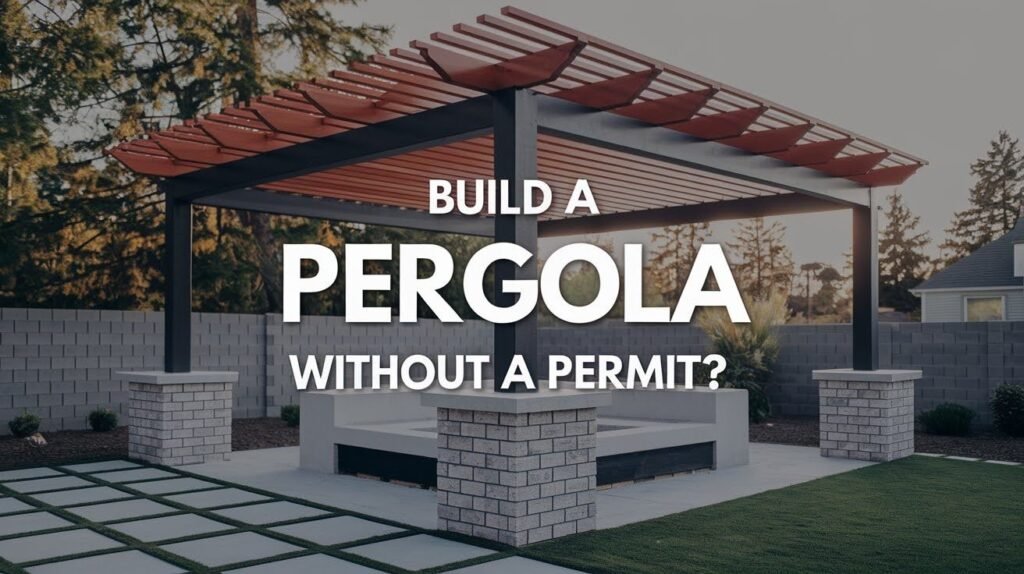Building a pergola in your backyard seems simple enough. You buy the materials, follow the instructions, and enjoy your new outdoor space. But wait, do you need a permit first? Many homeowners skip this crucial step.
They assume small structures don’t require official approval. This mistake can cost thousands in fines and force you to tear down your hard work. A pergola is an outdoor structure with vertical posts supporting crossbeams and an open lattice roof.
While it looks straightforward, local building codes often require permits for these installations. This article covers everything you need to know about pergola permits. You’ll learn when permits are required, how to apply, and what happens if you skip this step.
We’ve researched building codes nationwide and spoken with contractors to give you reliable information. By the end, you’ll confidently move forward with your pergola project, the right way.
Why Are Permits Required for Pergolas?
You might wonder why the government cares about your backyard pergola. The answer comes down to safety and community standards.
The Purpose of Building Permits
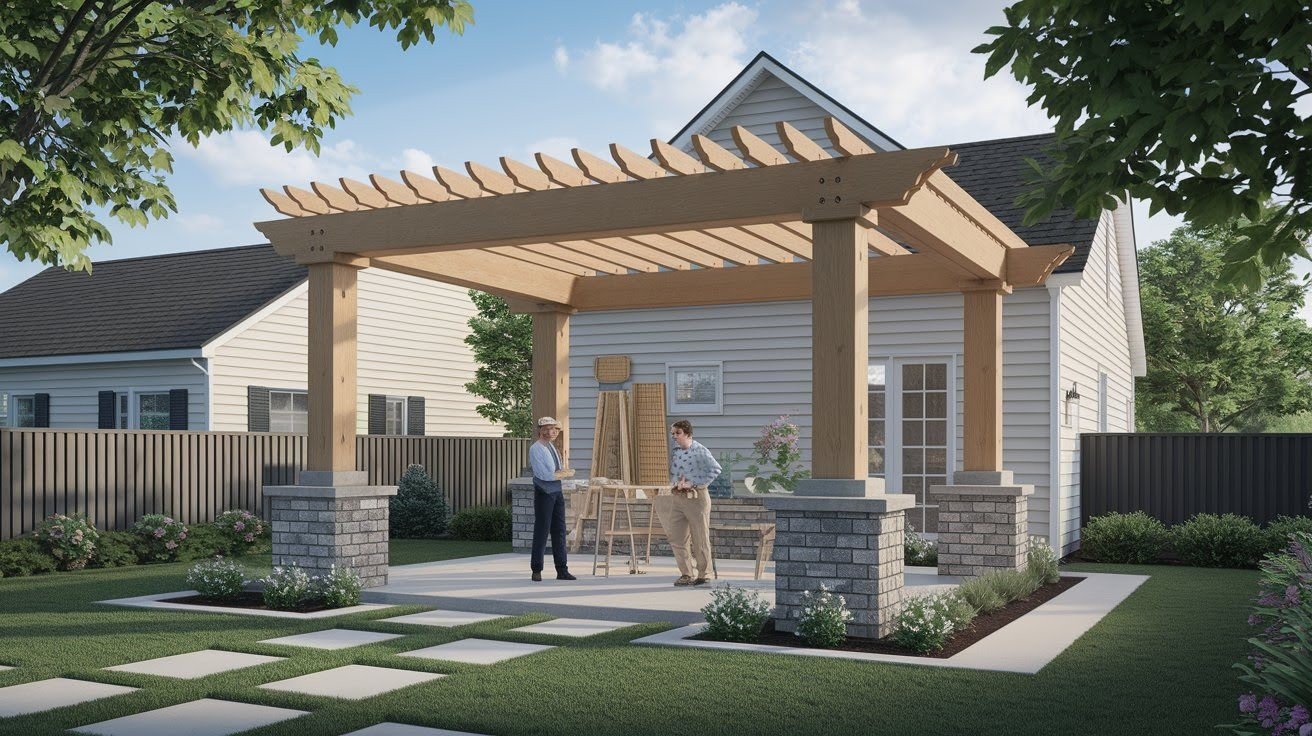
Building permits exist to protect you and your neighbors.
Here’s what they accomplish:
Public Safety First Permits ensure your pergola can handle wind, rain, and snow loads. A poorly built structure might collapse during a storm. This could hurt someone or damage property.
Fire Prevention Matters Some areas require fire-resistant materials. California residents know this well. Dry conditions make certain wood types risky. Permits help officials verify you’re using safe materials.
Quality Control Permits prevent shoddy construction. Officials check that your pergola meets minimum standards. This protects your investment and maintains neighborhood property values.
When Is a Permit Required?
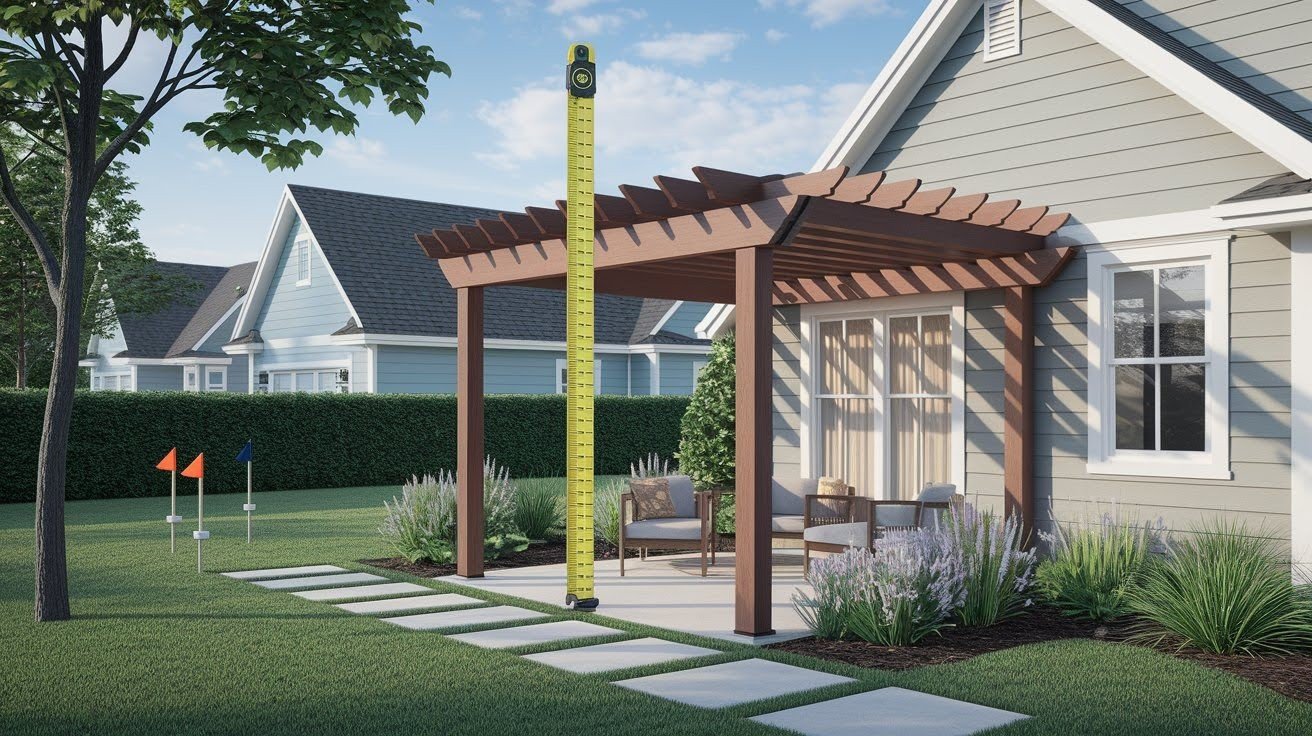
The rules change based on where you live. No universal standard exists across the country.
Size and Height Limits Most cities allow small pergolas without permits.
Common thresholds include:
- Under 10 feet tall
- Less than 120 square feet
- More than 5 feet from property lines
Location-Specific Rules San Francisco requires permits for most pergolas over 6 feet tall. Palo Alto has stricter setback requirements near neighbors’ homes. Always check your local building department first.
Your city’s website usually lists permit requirements. When in doubt, make a quick phone call.
Consequences of Building a Pergola Without a Permit
Skipping the permit process might seem like a smart shortcut. Unfortunately, the risks far outweigh any temporary convenience.
Legal and Financial Penalties
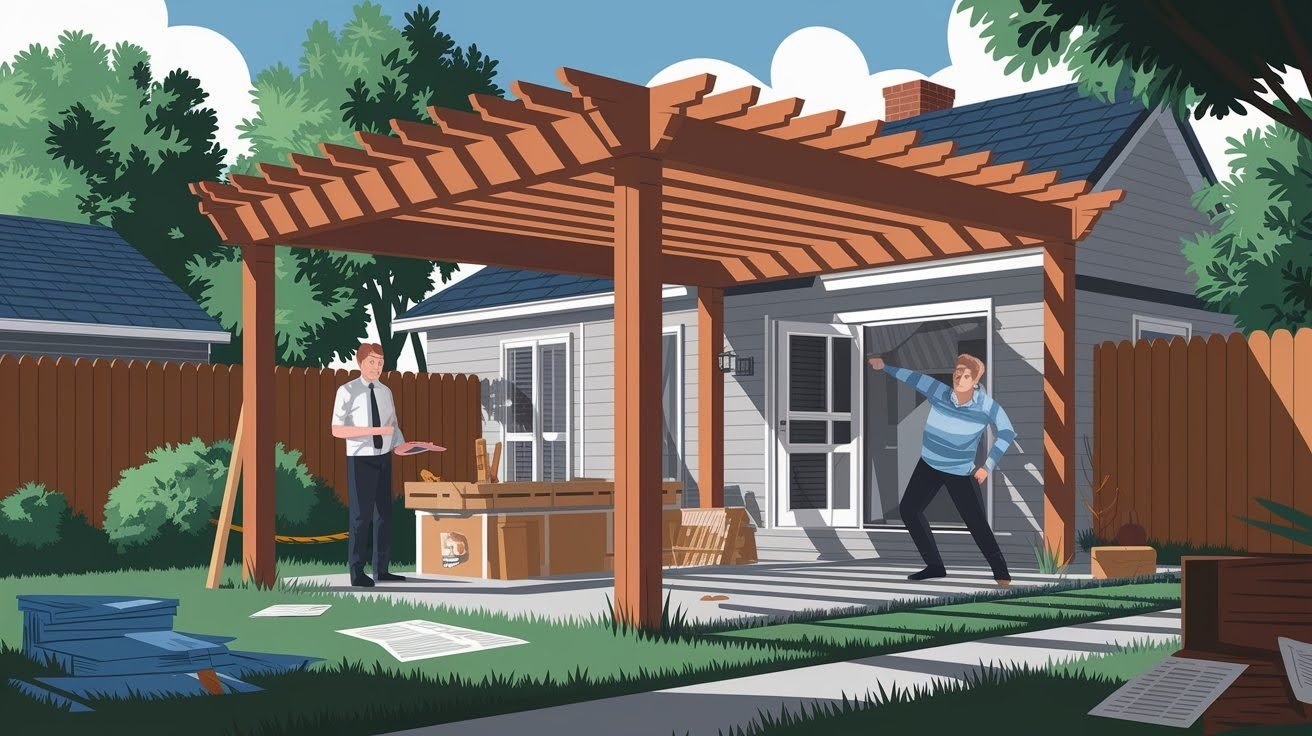
Getting caught without a permit hits your wallet hard.
Heavy Fines Cities don’t mess around with unpermitted work. Fines can reach nine times your original construction cost. A $2,000 pergola could result in $18,000 in penalties. Some areas charge daily fines until you fix the problem.
Forced Removal Officials might order you to tear down your pergola completely. You’ll lose your investment and still owe fines. Some homeowners spend more on removal than the original build cost.
Future Permit Problems Once flagged, your property gets extra scrutiny. Future permits take longer and cost more. Officials will inspect everything closely.
Safety and Liability Risks

Unpermitted structures create serious dangers.
Personal Injury Code violations often lead to accidents. Poor foundation work causes collapses. Incorrect height clearances create head injuries. You’re responsible for any harm that occurs.
Insurance Nightmares Your insurance company might deny claims related to unpermitted work. A storm damages your pergola and deck? You could pay out of pocket for everything.
Legal Trouble If someone gets hurt, you face potential lawsuits. Without permits, proving your structure was safe becomes nearly impossible.
Resale and Property Value Issues

Unpermitted work haunts you when selling.
Inspection Failures Home buyers order inspections. Unpermitted pergolas raise red flags immediately. Inspectors document everything for potential buyers.
Deal Breakers Many buyers walk away from properties with permit issues. Others demand huge price reductions. Your selling timeline gets extended significantly.
Lower Property Values Unpermitted work actually decreases your home’s value. Banks hesitate to approve mortgages. The headaches multiply quickly.
How Do Cities Find Out About Unpermitted Pergolas?
You might think your backyard pergola will stay hidden from city officials. Think again. Cities have multiple ways to spot unpermitted work.
Common Detection Methods

Neighbor Reports Your neighbors are the most common source of complaints. Property disputes often trigger reports. Someone upset about noise, parties, or blocked views might call the city.
Many cities now offer online complaint forms. Neighbors can report suspected violations with just a few clicks. They can even upload photos as evidence.
City Inspector Visits Building inspectors work in neighborhoods regularly. They spot new structures while checking other properties nearby. A keen eye notices fresh construction from the street.
Inspectors also respond to other calls in your area. They might see your pergola while checking a neighbor’s fence or pool installation.
Technology Catches Everything Cities increasingly use aerial photography and satellite images. They compare current photos with older ones from permits databases. New structures show up clearly in these comparisons.
What Type of Pergolas Usually Require Permits?
Not all pergolas need permits, but many do. Understanding which types require approval helps you plan correctly.
Custom-Built Pergolas
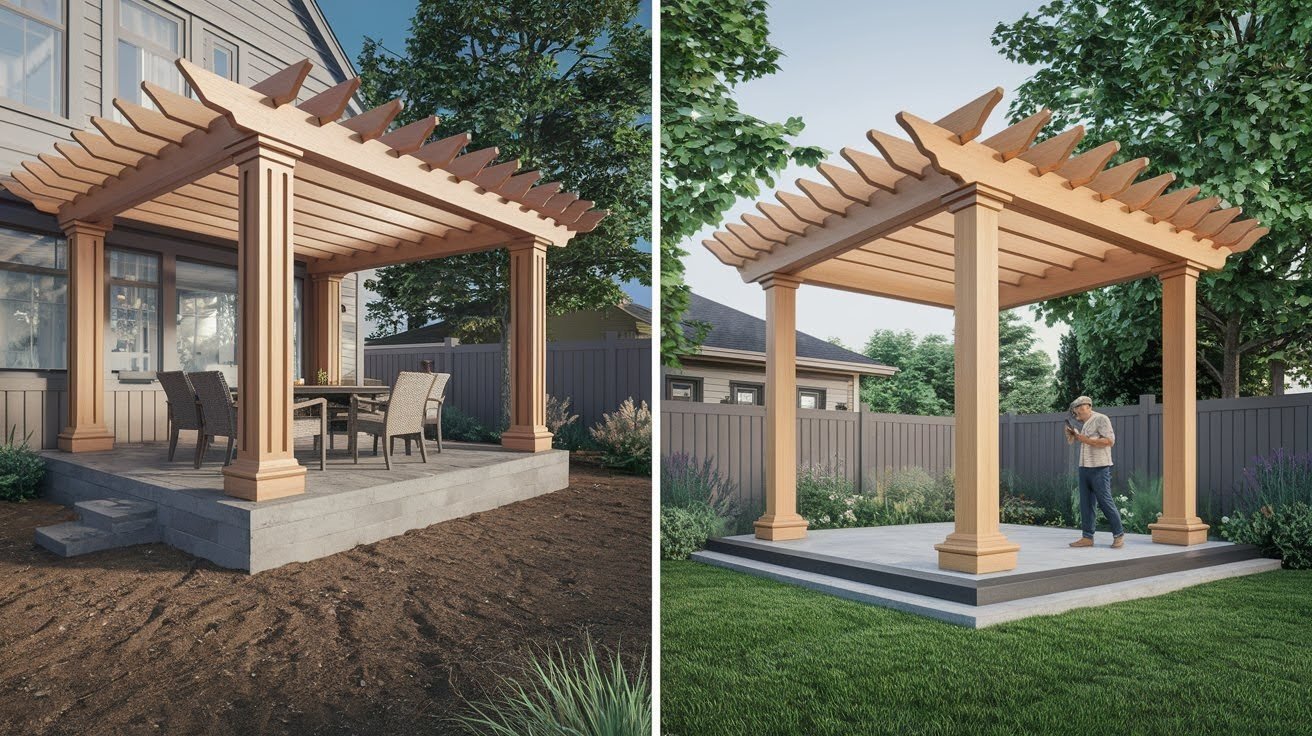
Custom pergolas almost always need permits. Their unique designs and permanent foundations trigger most city requirements.
Attached vs. Freestanding Attached pergolas connect to your house, deck, or garage. These structures almost universally require permits. They affect your home’s structural load and often need engineered plans.
Freestanding pergolas have better odds of permit exemption. But size and location still matter. Large freestanding structures often need approval too.
Size Matters Most Most cities set size thresholds. Common limits include:
- Under 200 square feet
- Maximum height of 10-12 feet
- Minimum setbacks from property lines
Exceed these limits and you’ll need a permit.
Foundation Depth Concrete footings deeper than 18-24 inches often trigger permits. Shallow post installations might avoid requirements. Check your local rules for specific depth limits.
Pre-Built Pergola Kits
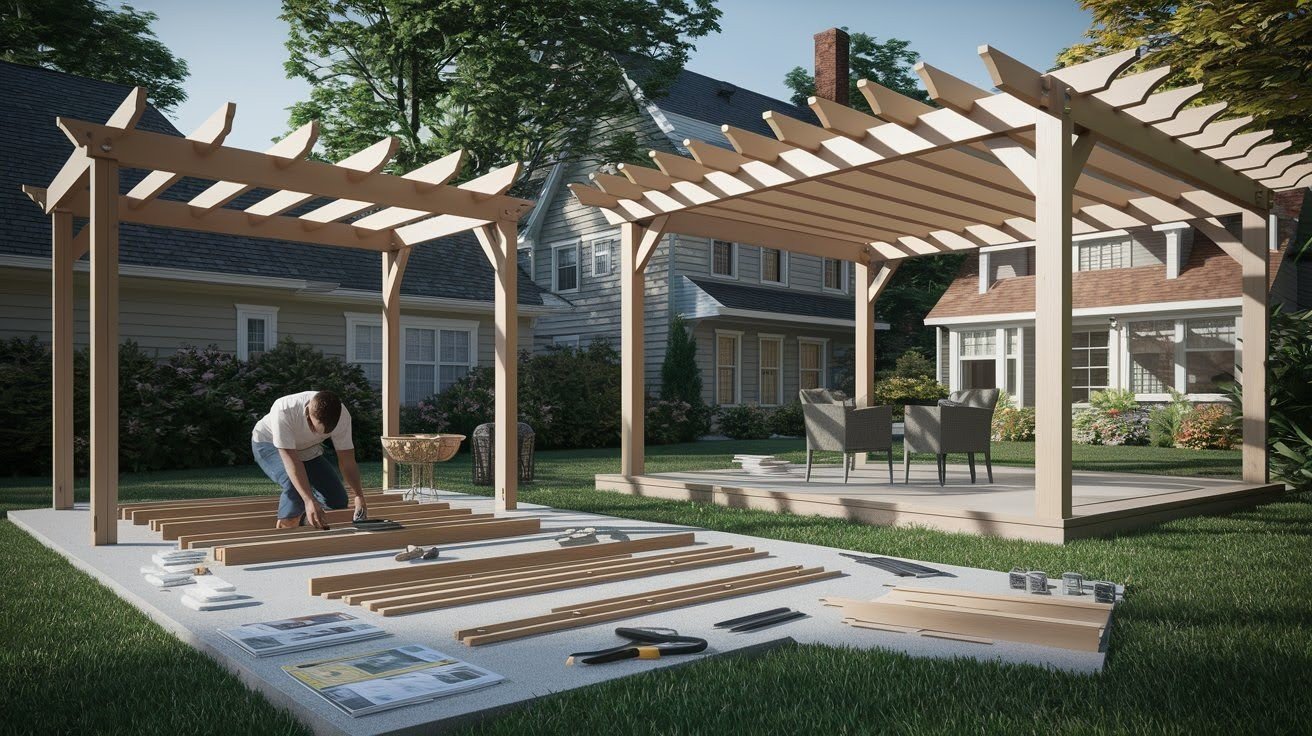
Kit pergolas seem simpler, but permits might still apply.
Size Still Counts Kit size determines permit needs. A small 8×8 kit might slip under requirements. A large 12×20 kit probably won’t.
Installation Method Bolt-together kits on concrete pads often avoid permits. Kits requiring concrete footings usually need approval.
Special Restrictions Homeowner associations (HOAs) often require approval regardless of city rules. Historic districts have their own requirements too. Some areas ban certain materials or colors entirely.
Always check multiple sources before assuming your kit pergola is exempt.
How Much Does a Pergola Permit Cost?
Permit costs vary widely across the country. Understanding fee structures helps you budget properly for your project.
Permit Fee Structure

Most cities base permit fees on your project’s total value. This includes materials, labor, and any professional services.
Value-Based Calculations Cities typically charge a percentage of construction costs. Common rates range from 1% to 3% of total project value. A $5,000 pergola might cost $50 to $150 in permit fees.
Some areas use flat fee structures instead. These range from $25 for simple structures to $200 for complex designs.
Project Value Estimates You’ll need to provide cost estimates when applying.
Include everything:
- Lumber and hardware
- Concrete for footings
- Professional installation costs
- Any electrical work for lighting
Cities can verify these numbers. Lowballing estimates might trigger additional scrutiny.
Additional Costs
Basic permit fees are just the starting point.
Plan Review Fees Complex pergolas need engineered drawings. Plan review fees add $100 to $500 to your total cost. Structural engineers charge separate fees for their services.
Inspection Charges Most permits include one inspection visit. Additional inspections cost $50 to $150 each. Failed inspections mean paying for return visits.
Rush Processing Need your permit quickly? Expedited processing costs extra. Rush fees range from $50 to $300 depending on your timeline.
Budget at least $200 to $800 total for permits and related costs. Complex projects cost significantly more.
How to Avoid These Consequences
Smart planning prevents permit problems. Take these steps before starting your pergola project.
Check with Local Authorities First

Your first stop should be the local building department. Don’t guess about permit requirements.
Contact Building Departments Call your city or county building office directly. Explain your pergola plans in detail.
Ask about:
- Size and height limits
- Setback requirements from property lines
- Foundation depth restrictions
- Required materials or fire ratings
Most departments offer free preliminary consultations. Take advantage of this service.
Get Everything in Writing Request written confirmation if they say no permit is needed. This protects you if rules change or officials disagree later. Email requests create paper trails.
Review HOA Guidelines Homeowner associations often have their own rules. These apply even when cities don’t require permits.
Check your HOA documents for:
- Architectural review requirements
- Approved materials and colors
- Design restrictions
- Neighbor notification rules
Submit HOA applications early. Approval processes take weeks or months.
Work With a Reputable Pergola Contractor

Professional contractors handle permits routinely. They know local codes and requirements.
Permit Handling Services Experienced contractors often manage the entire permit process. They prepare applications, submit drawings, and schedule inspections. This removes the burden from you.
Local Code Knowledge Professional installers understand regional requirements. They know which materials work best in your climate. They also maintain relationships with local officials.
Example Success Story Companies like StruXure NorCal specialize in permitted pergola installations. They handle everything from initial applications to final inspections. Their local expertise streamlines the entire process.
Choose contractors who guarantee permit compliance. This protects your investment and ensures proper installation.
Key Tips for Pergola Permits
Before You Start
- Call your building department before buying materials
- Get permit requirements in writing from officials
- Check HOA rules even if the city doesn’t require permits
- Measure your planned pergola against local size limits
- Research setback requirements from property lines
During Planning
- Budget extra money for permits and inspections
- Include all project costs when estimating permit fees
- Consider hiring professionals for complex designs
- Plan for multiple inspection visits
- Allow extra time for permit approval processes
Avoiding Problems
- Never assume small structures don’t need permits
- Don’t start construction before getting approval
- Keep all permit documentation in a safe place
- Schedule inspections promptly when required
- Address inspector concerns immediately
Conclusion
Your pergola should enhance your outdoor living space, not create legal headaches. Taking shortcuts on permits turns a home improvement into a costly nightmare.
The permit process protects you in multiple ways. It ensures your structure meets safety standards. It prevents expensive fines and forced removals. Most importantly, it gives you peace of mind knowing everything was done correctly.
Yes, permits cost money and take time. But these small inconveniences pale compared to the consequences of unpermitted work. Fines, insurance denials, and resale problems cost far more than doing things right from the start.
Contact your local building department before breaking ground. Work with experienced contractors who understand permit requirements. Your future self will thank you for making smart choices today.
Frequently Asked Questions
Do all pergolas need building permits?
No, not all pergolas require permits. Most cities exempt small structures under specific size limits, typically 120-200 square feet and less than 10 feet tall.
How much do pergola permits typically cost?
Permit fees usually range from $50 to $300, based on your project’s total value. Additional costs for plan reviews and inspections can add $100 to $500 more.
What happens if I build without a permit and get caught?
You could face fines up to nine times your construction cost and be forced to remove the structure. Future permits become more difficult and expensive to obtain.
How long does the permit approval process take?
Simple pergola permits typically take 2-4 weeks for approval. Complex designs requiring engineered plans can take 6-8 weeks or longer.
Can I apply for a pergola permit myself?
Yes, most homeowners can handle simple permit applications independently. However, complex projects often benefit from professional contractors who understand local codes and requirements.


